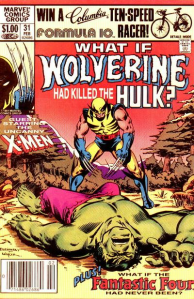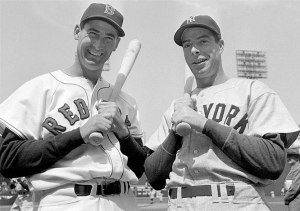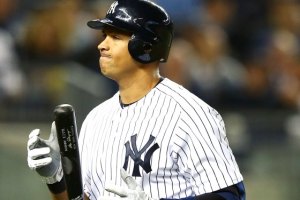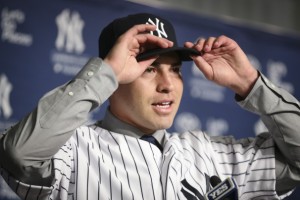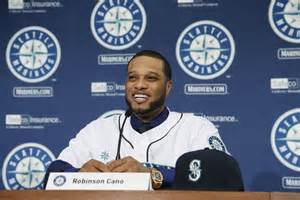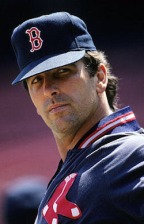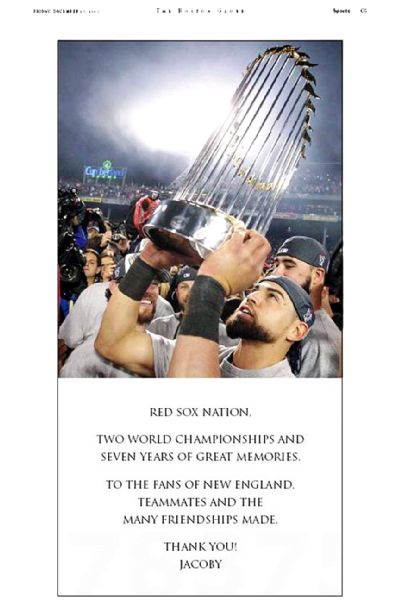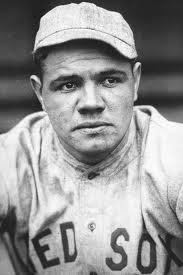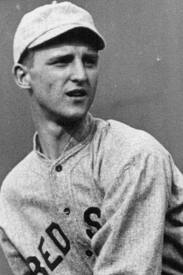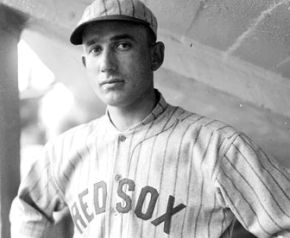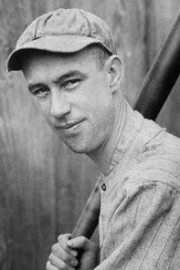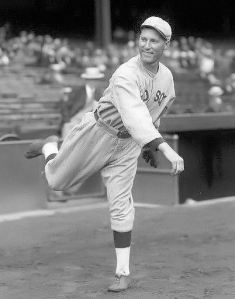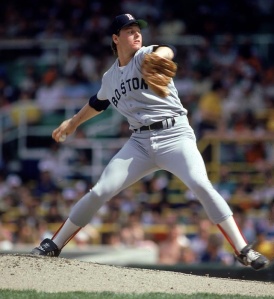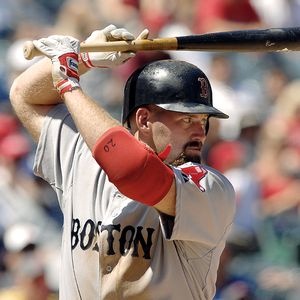Tagged: New York Yankees
David Price and the best uniform numbers ever
From ESPN Boston: David Schoenfield, ESPN Senior Writer
David Price was officially introduced as a member of the Boston Red Sox on Friday. Price has worn No. 14 throughout his career — with Tampa Bay, with Detroit and with Toronto — but that number is retired in Boston in honor of Hall of Famer so Jim Rice so he chose No. 24.
That’s a pretty storied number in Red Sox history. Dwight Evans — a better player than Rice but not in the Hall of Fame — wore it from 1973 to 1990 and he’s one of the most popular players in Red Sox history. But the Red Sox only retire the numbers of Hall of Famers, so five players have worn it since Evans. One of those was Manny Ramirez, who wore it from 2001 to 2008.
That got me to thinking: What’s the greatest jersey number for one team? By that, I mean worn by more than one great player. Here are some nominees:
- Boston Red Sox No. 24: Dwight Evans, Manny Ramirez, David Price. Total WAR: 99.4 and counting. (That WAR is only for the players listed and only while with the Red Sox; many others have worn the number, but I’m looking at major stars only. Good luck if you want to invest the time for all players.)
- New York Yankees No. 8: Bill Dickey and Yogi Berra. Two Hall of Fame catchers, the number is now retired. Total WAR: 112.3.
- New York Yankees No. 9: Roger Maris, Graig Nettles, Hank Bauer, Charlie Keller and Joe DiMaggio. The number is retired in Maris’ honor, although Nettles, Keller and Bauer each accumulated more WAR while with the Yankees. DiMaggio wore No. 9 as a rookie before shifting to No. 5. Total WAR: 145.6 (using just the one season for DiMaggio). Might be hard to beat that total.
- Chicago Cubs No. 31: Fergie Jenkins and Greg Maddux. Two Hall of Fame right-handers, the number is now retired in honor of both. Total WAR: 87.1.
- Seattle Mariners No. 51: Randy Johnson and Ichiro Suzuki. Who gets ultimate retirement honors? I’m guessing the Mariners will retire it in honor of both once Ichiro makes the Hall of Fame. Total WAR: 96.1.
- Detroit Tigers No. 3: Alan Trammell, Dick McAuliffe, Ian Kinsler, Mickey Cochrane (1934-1937), Charlie Gehringer (1931). This is interesting since two Hall of Famers wore it for a short period plus Trammell, who should be in the Hall of Fame, and McAuliffe, a three-time All-Star. Total WAR: 132.8.
- Pittsburgh Pirates No. 21: Arky Vaughan and Roberto Clemente. Total WAR: 147.8. Vaughan is a Hall of Famer, one of the most underrated players of the 1930s. He wore No. 21 with the Pirates from 1932-1939 and then changed to No. 3 and then No. 5 for some reason. I included only his 1932-1939 WAR but that was enough to push this duo above the Yankees’ No. 9 guys.
- San Francisco Giants No. 25: Bobby Bonds and Barry Bonds. Total WAR: 150.3. Barry accounts for 112.3 of that. Not included: Dan Gladden. But if you throw in 19.3 WAR from Whitey Lockman you’re up to 169.6.
- Los Angeles Dodgers No. 6: Carl Furillo, Ron Fairly and Steve Garvey. No Hall of Famers, but three good players. Garvey’s number is retired, oddly enough, by the Padres but not the Dodgers. Total WAR: 84.5.
- New York Yankees No. 15: Red Ruffing, Tommy Henrich (1946-1950), Tom Tresh, Thurman Munson. The number is retired for Munson, although Ruffing is in the Hall of Fame. Total WAR: 125.5.
- Los Angeles Angels No. 27: Vladimir Guerrero and Mike Trout. Vlad played with the Angels for only six seasons, but he did win an MVP award wearing No. 27. Hmm, how many teams have had two different players win an MVP award wearing the same number? Total WAR: 60.7 and counting.
By this measure, Bonds and Bonds is enough to make the Giants’ No. 25 the best number ever. Did I miss any other candidates? You can go to Baseball-Reference.com to check out the number history for each franchise.
____________________________________________
Okay, I’ll buy some of this, makes for great social media-war type stuff, but I think under these conditions, it’s just too simple and doesn’t really get into the actual subject matter of “Best Number”. Sure, it’s about the number and not the actual players who wore them outside of their WAR, I can see that, but being a bit more traditionalist… eh. How much of the actual Barry Bonds numbers can you, PED use aside, factor into the #25
argument? As the Riddler once said, “Too many questions…”
24 is actually one of my fave Red Sox numbers, mainly for Dewey and
having grown up watching him until his final year in Baltimore (yes, Dwight Evans played a year for the Orioles). I was heartbroken when Manny wore it, simply because it was Dewey’s and it should have been Dewey’s… ’nuff said. Yes other players had worn it between them and since, but again, I don’t really look at Kevin Mitchell’s short stint patrolling the famous Fenway RF in #24 as anything dramatic, nor anyone else’s stints.
But added up WAR aside… how do you get past 9? Sure that’s based on the player who wore it but still… Teddy Ballgame as a singular baseball individual, never mind war hero (as well as WAR hero in stats terms) and American Icon (yes, he was a foul-mouthed bastard but his legacy goes well beyond that, Thank You) who still overshadows the combined three individuals mentioned in the above article. And yes, Dwight Evans is HOF worthy, just was never the ‘Superstar’ of the team as he played with Yaz, Fisk, Rice, Boggs (all HOF) and the likes of Roger Clemens, Fred Lynn, Tony Pena and other lightning rods for the press. He never had a long collection of league-leading years but trended upwards during the latter half of that career. That however, is an argument that has been made and shall be made again…

Oh, NOTE: Yes, the Red Sox have made it policy that retired numbers are an honor for players who played 10 years in the uniform, retired with the team and made the HOF… except Johnny Pesky, whose 4.2 billion years of service to the organization merited his #6 be retired.

I’ve made a case for the Red Sox to implement an ‘Honored’ number selection, where specific player’s numbers are posted with their names in road jersey style upon the center field interior of the bleachers wall, keeping that number in uniform rotation but still paying homage to the player. Example: 21 Clemens in Navy Blue numbers/letters (or Red depending on the away jersey style you prefer… I liked the original non-name roadies and the 2009 to 2013 version), 26 Boggs or 24 Evans, etc., This keeps the number in rotation (though 21 may never be worn either way… as it should be, all the PED rhetoric aside, Rocket’s Sox years were his prime HOF years) but still gives the deserved recognition to those who wore it before. The Toronto Maple Leafs have had such a system in place for years.
Just my humble opinion.
p.s. If the continuing embargo versus career DH’s in the HOF, where will this leave Big Papi in the retired number conversation??
Almost Teammates….
From ESPN: Boston
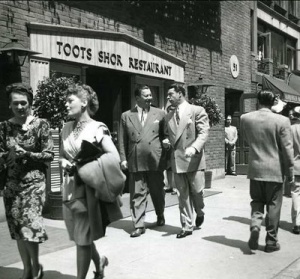 There’s an old story that in April of 1947, over maybe a few too many drinks at Toots Shor’s restaurant in New York, Yankees owner Dan Topping and Red Sox owner Tom Yawkey had agreed to the biggest trade in baseball history: Joe DiMaggio for Ted Williams. DiMaggio would get to play in Fenway Park with its inviting Green Monster instead of cavernous Yankee Stadium (457 feet to deep left-center back then) and Williams would get to move to Yankee Stadium with its short right-field porch.
There’s an old story that in April of 1947, over maybe a few too many drinks at Toots Shor’s restaurant in New York, Yankees owner Dan Topping and Red Sox owner Tom Yawkey had agreed to the biggest trade in baseball history: Joe DiMaggio for Ted Williams. DiMaggio would get to play in Fenway Park with its inviting Green Monster instead of cavernous Yankee Stadium (457 feet to deep left-center back then) and Williams would get to move to Yankee Stadium with its short right-field porch.
Yawkey woke up the next morning and came to his senses, telling 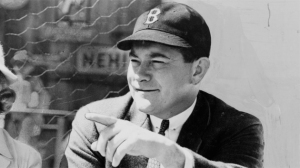 Topping that his people in Boston wouldn’t do the trade. The Red Sox had just won the pennant in 1946, Williams was four years younger, Boston already had an excellent center fielder in Joe’s brother Dom and Joe had undergone offseason surgery on his heel. There wasn’t a good reason for Boston to consider such a move. In checking biographies on both Williams and DiMaggio, this story appears to come from a Dave Anderson column from the New York Times in 1980 (both Yawkey and Topping were dead by then) and not from contemporaneous newspaper accounts. Anderson’s column also suggests Yawkey, after turning down Williams for DiMaggio, asked Topping to include his “little left fielder” — a rookie named Yogi Berra.
Topping that his people in Boston wouldn’t do the trade. The Red Sox had just won the pennant in 1946, Williams was four years younger, Boston already had an excellent center fielder in Joe’s brother Dom and Joe had undergone offseason surgery on his heel. There wasn’t a good reason for Boston to consider such a move. In checking biographies on both Williams and DiMaggio, this story appears to come from a Dave Anderson column from the New York Times in 1980 (both Yawkey and Topping were dead by then) and not from contemporaneous newspaper accounts. Anderson’s column also suggests Yawkey, after turning down Williams for DiMaggio, asked Topping to include his “little left fielder” — a rookie named Yogi Berra.
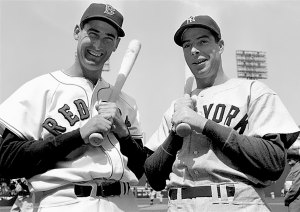 The Berra part sounds a little apocryphal to me — for one thing, Berra had only played a few games in right field in April of that year, not left, and had hit .225 with no home runs. It doesn’t seem likely that Yawkey would have viewed Berra as the difference-maker to swing the trade. While the Red Sox never won another pennant with Williams, it would have been a terrible deal for them: DiMaggio would play just five more seasons and 625 games while Williams would play another 1,556 games (not to mention the time he missed in 1952-53 to resume military duty for the Korean War).
The Berra part sounds a little apocryphal to me — for one thing, Berra had only played a few games in right field in April of that year, not left, and had hit .225 with no home runs. It doesn’t seem likely that Yawkey would have viewed Berra as the difference-maker to swing the trade. While the Red Sox never won another pennant with Williams, it would have been a terrible deal for them: DiMaggio would play just five more seasons and 625 games while Williams would play another 1,556 games (not to mention the time he missed in 1952-53 to resume military duty for the Korean War).
What I didn’t know until recently reading Richard J. Tofel’s book “A Legend in the Making: The New York Yankees of 1939” is that DiMaggio and Williams could have been teammates if not for the twists of fate. Imagine a Yankees outfield with DiMaggio and Williams side by side. Not that the Yankees struggled without Williams.
DiMaggio had first starred with his hometown San Francisco Seals of the Pacific Coast League as an 18-year-old in 1933, hitting .340 with 28 home runs in 187 games, including a 61-game hitting streak. Major league teams attempted to purchase DiMaggio — the Yankees reportedly offered $75,000 — but Seals owner Charley Graham elected to keep his prized asset for 1934. Remember, back then most of the minor league teams were independent of the majors, selling players to big league teams or even making trades.

In May of that year, DiMaggio hurt his knee climbing into a car. In his autobiography, DiMaggio said he had been visiting his sister, took a cab home and slipped on the climb out because “my left foot must have fallen asleep from the awkward position in which I was sitting.” Richard Ben Cramer’s biography of DiMaggio, “Joe DiMaggio: The Hero’s Life,” reports that the San Francisco Examiner at the time reported DiMaggio had slipped in the early hours of the morning at Fourth and Market — an area full of bars and nightclubs. Cramer’s insinuation that DiMaggio may have been “loaded” is speculative, but DiMaggio’s own account certainly isn’t true.
Anyway, DiMaggio missed some time, attempted to play through the injury and didn’t hit as well when he returned. He still managed to hit .341 with 12 home runs in 101 games but Graham, who had been hoping for $100,00 for DiMaggio before the injury, now saw interest wane in his young star.
The Yankees, however, remained interested. West Coast scout Joe Devine had loved DiMaggio and he had a local scout named Bill Essick check into DiMaggio’s knee. According to Cramer’s book, the Yankees paid for an orthopedic specialist to examine DiMaggio and the surgeon reported that the 19-year-old should be able to recover from the injury. Essick told Yankees general manager Ed Barrow, “Don’t give up on DiMaggio. I think you can get him cheap.”
He was right. With other teams out of the running or short on cash during the Depression, the Yankees got DiMaggio for $25,000 and five prospects, with the caveat that the Seals could keep DiMaggio for one more year and the Yankees could get their money back if DiMaggio’s knee didn’t hold up. He hit .398 with 34 home runs in 1935 and joined the Yankees in 1936. DiMaggio was an immediate star, hitting .323 with 29 home runs and 125 RBIs, and the Yankees won the first of four consecutive World Series titles.
* * * *
Williams was another California kid, from San Diego. While DiMaggio was tearing up the American League in 1936, Williams was playing at Hoover High School that spring. Tofel writes,
For the Yankees, Williams was the one who got away. Bill Essick, the same Yankee scout who recognized late in 1934 that DiMaggio was still worth $25,000 despite his knee injury, failed to sign Williams eighteen months later. Essick offered a $500 signing bonus but refused to meet Williams’s mother’s demand for $1,000.
Did the Yankees really lose Williams over $500? I had never heard that story before. I checked out Ben Bradlee Jr.’s comprehensive Williams biography — “The Kid: The Immortal Life of Ted Williams” — that came out in 2013 for more detail. As Williams was finishing up at Hoover, Bradlee reports that scouts had been tracking Williams for some time, with a local bird dog named Herb Benninghoven, who worked for the Cardinals, Williams’ “most ardent suitor.” Also interested in Williams was a bird dog named Elmer Hill, who worked for Essick. After Williams hit a long home run in an American Legion game, Hill and Essick showed up at Williams’ house.
Bradlee quotes Williams’ autobiography:
Essick was as anxious as anyone to get me. I’ll never forget what he said: “Ted, if I didn’t think you were going to be a New York Yankee, I’d never sign you.” Maybe he said that to everybody, but that sure impressed me. I think he offered me $200 a month and a $500 bonus if I made the team at [Class A] Binghamton, New York, but the story is my mother asked for a $1,000 bonus and Essick refused.
Note carefully the wording. Williams isn’t exactly saying that he didn’t because his mother asked for more money, but seems to be repeating a story that had been told by others.
Still, the Yankees remained interested, later offering $250 a month or $400 a month if he made the Yankees’ Pacific Coast League affiliate, and Hill apparently believed that an agreement in principle was in place once Williams finished high school. The Tigers also scouted Williams but area scout Marty Krug deemed Williams too skinny. The Los Angeles Angels of the PCL tried to sign Williams, but Ted’s father didn’t like the team’s manager. Benninghoven, still interested in Williams, invited him to a Cardinals tryout in Fullerton, where Branch Rickey would be present. Bradlee writes, “At the tryouts, the speed-conscious Rickey required recruits to run race after race with numbers pinned to their backs. But the day before the tryout, Ted was hit by a pitch on his thigh, just above the knee. Slow anyway, Ted was made even less mobile by the injury, and he largely went through the motions. Rickey showed no interest in him.”
 Benninghoven did finally get the Cardinals to make an offer, but Williams figured St. Louis wasn’t the quickest way to the majors. Sam Williams, Ted’s father, reportedly asked the Yankees for another $25 a month. In a 1957 letter, Hill wrote that he agreed to this with Williams and his mother. Ted’s parents had a strained marriage, often living apart, and it appears Sam Williams was working in Sacramento at the time. Williams ended up signing on June 25 with the San Diego Padres, a new team that year in the PCL, for $150 a month. For the cash-strapped Williams family, apparently the fact that the Padres had agreed to pay him for the entire month of June was a crucial factor, along with Ted’s mother liking the club’s owner.
Benninghoven did finally get the Cardinals to make an offer, but Williams figured St. Louis wasn’t the quickest way to the majors. Sam Williams, Ted’s father, reportedly asked the Yankees for another $25 a month. In a 1957 letter, Hill wrote that he agreed to this with Williams and his mother. Ted’s parents had a strained marriage, often living apart, and it appears Sam Williams was working in Sacramento at the time. Williams ended up signing on June 25 with the San Diego Padres, a new team that year in the PCL, for $150 a month. For the cash-strapped Williams family, apparently the fact that the Padres had agreed to pay him for the entire month of June was a crucial factor, along with Ted’s mother liking the club’s owner.
Williams played sparingly the rest of the season for the Padres, 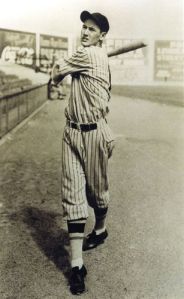 hitting .271 with no home runs in 107 at-bats. In 1937, at the age of 18, he hit .291 with 23 home runs. Now, just about every major league team wanted Williams. The Yankees were still interested as were the Tigers and New York Giants. Casey Stengel, who had been hired as manager of the Boston Bees (Braves) for 1938, had been out of baseball in 1937 but saw Williams when he played in Stengel’s hometown of Oakland and liked the kid’s potential. The Bees made an offer.
hitting .271 with no home runs in 107 at-bats. In 1937, at the age of 18, he hit .291 with 23 home runs. Now, just about every major league team wanted Williams. The Yankees were still interested as were the Tigers and New York Giants. Casey Stengel, who had been hired as manager of the Boston Bees (Braves) for 1938, had been out of baseball in 1937 but saw Williams when he played in Stengel’s hometown of Oakland and liked the kid’s potential. The Bees made an offer.
The Yankees fell out of the bidding, perhaps because of Joe Devine’s scouting report that said Ted “is a very slow lad, not a good outfielder now, just an average arm. There is no doubt Williams will never be a fast enough to get by in the majors as an outfielder. His best feature now is that he shows promise as a hitter, but good pitching so far has stopped him cold.”

And then there were the Red Sox, who had closely watched Williams all season and had discussed a deal with Padres owner Bill Lane. Lane held off during the season but told other teams that he had promised Red Sox general manager Eddie Collins the right of first refusal. At the winter meetings that year, however, Yawkey suddenly seemed reluctant to spend the money, saying he was tired of buying other teams’ players and that Boston was trying to develop its own farm system. Collins insisted they needed to make an exception for Williams.
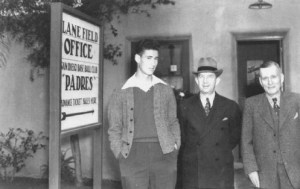 Lane was about to give up on the Red Sox and sell Williams to another team when the two sides finally agreed on a deal: $25,000 and four players for Williams. The Red Sox were so lacking in minor leaguers at the time that Collins had farm director Billy Evans quickly acquire four players he could then trade to the Padres. The Tigers ($30,000) and Giants ($31,000) had reportedly offered more money, but Williams belonged to Boston.
Lane was about to give up on the Red Sox and sell Williams to another team when the two sides finally agreed on a deal: $25,000 and four players for Williams. The Red Sox were so lacking in minor leaguers at the time that Collins had farm director Billy Evans quickly acquire four players he could then trade to the Padres. The Tigers ($30,000) and Giants ($31,000) had reportedly offered more money, but Williams belonged to Boston.
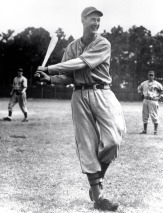 Williams spent 1938 at Minneapolis, where he hit .366 with 43 home runs. He joined the Red Sox in 1939 and would spend much of the next 12 years chasing DiMaggio and the Yankees. While both players were active, the Red Sox would win just that one pennant in 1946, five times finishing in second place.
Williams spent 1938 at Minneapolis, where he hit .366 with 43 home runs. He joined the Red Sox in 1939 and would spend much of the next 12 years chasing DiMaggio and the Yankees. While both players were active, the Red Sox would win just that one pennant in 1946, five times finishing in second place.
* * * *
How close did Williams come to signing with the Yankees? It’s difficult to say with any degree of accuracy all these years later. Certainly, dealing with Williams’ parents was difficult. The family was poor — Williams wrote that he was embarrassed to bring scouts to his house — and strapped for cash, thus wanted some sort of signing of bonus. Williams’ autobiography makes it appear as if he was willing to sign with the Yankees; when Boston finally purchased him from the Padres, he wrote that he was disappointed. “The Red Sox didn’t mean a thing to me. A fifth-, sixth-place club [the Red Sox had finished in sixth in 1936], the farthest from San Diego I could go. I certainly wasn’t a Boston fan.”
The scout Elmer Hill seemed to blame Williams’ mother for reneging on an agreement, but that could be some re-imagining of the facts years later. Or maybe the Yankees really did just cheap out in the end.
One more thing, however. Williams didn’t actually graduate from high school in the spring of 1936. He still had one more semester to go. Doesn’t it make sense that maybe Williams’ mother wanted him to finish school? He could sign with the Padres, get the family a little money in the short-term, play for them that summer and then finish his last semester of school in the fall. Also, Lane had apparently promised the Williams family a percentage of any sale in the future, so May Williams would eventually get her bonus money.
In fact, when Williams was sold, the Williams family asked for $5,000 from Lane, who now refused to give the family anything. The Williamses said Ted was a free agent and could sign with any team. All winter, reporters wrote on the squabbles going on with the Williams family, the Padres and the Red Sox. Commissioner Kenesaw Mountain Landis ordered Collins to make sure he got Williams to sign a Red Sox contract.
He eventually did, but not until mid-February, and not until the Red Sox finally gave May Williams $2,500.
(Most of the information here was gathered from the books by Ben Bradlee Jr. and Richard Ben Cramer. I recommend both.)
Alex Rodriguez: What If..?
In Comic Books they are known as ‘What If?’ (Marvel) issues or ‘Elseworld’ (DC) tales, taking the established character out of their established norm and seeing what would have or could have happened if….
A decade later, we revisit called-off engagement between Rodriguez and Boston
From: Gordon Edes
They rank among the great what-might-have-been stories in Red Sox history.
What if an organization with a history of racial intolerance had given more than a sham tryout to Jackie Robinson or listened to the urgings of a scout named George Digby to sign a young outfielder named Willie Mays?

What if Red Sox owner Tom Yawkey had, in the cold light of morning, decided to follow through on the trade arranged over drinks the night before with Yankees co-owner Dan Topping, one in which the Sox would have swapped Ted Williams for Joe DiMaggio? (Note: This deal also was scuttled due to the Yankees reluctance to include a young catching prospect named Yogi Berra.)
And what if the Red Sox had succeeded in their audacious effort 10 years ago to acquire Alex Rodriguez, generally acknowledged as the best player in the game at the time, from the Texas Rangers?
Ten years ago Monday, Rangers owner Tom Hicks declared that effort “totally, totally dead.” He would soon send a letter to Rangers season-ticket holders pledging that Rodriguez would be the team’s shortstop on Opening Day 2004. Then, on Valentine’s Day, he traded him to George Steinbrenner’s Yankees.
With A-Rod now shamed and a shell of his former self, a player who went from being championed by the game’s ruling class to pariah, it is easy to regard Boston’s failed courtship as a blessing, a disaster averted.
But that’s with the benefit of hindsight. At the time, the Sox — and A-Rod — were bitterly disappointed that it did not come to pass, this deal first proposed by Hicks to the Red Sox within days of their crushing Game 7 loss to the New York Yankees in the 2003 ALCS.
 Hicks was looking to get out from under the game’s biggest contract, a $250 million, 10-year deal that in its first three years had not lifted the Rangers out of mediocrity. He asked for Nomar Garciaparra in return. The Sox countered by offering Manny Ramirez, whom they had placed on irrevocable waivers only weeks before without any takers.
Hicks was looking to get out from under the game’s biggest contract, a $250 million, 10-year deal that in its first three years had not lifted the Rangers out of mediocrity. He asked for Nomar Garciaparra in return. The Sox countered by offering Manny Ramirez, whom they had placed on irrevocable waivers only weeks before without any takers.
With that deal in play, Red Sox GM Theo Epstein made another at the winter meetings, arranging to trade Garciaparra to the White Sox for slugging outfielder Magglio Ordonez. That second trade was contingent on the A-Rod deal being approved, but when Epstein entered the hotel room of his new manager, Terry Francona, and rattled off a prospective lineup that included Johnny Damon, A-Rod, David Ortiz and Ordonez, on knees made unsteady by multiple surgeries, Francona climbed onto his bed and did an impromptu dance.
That same night, Epstein slipped out of the meetings in New Orleans and flew to New York to meet with Rodriguez and his then-wife, Cynthia. Owner John W. Henry had already met with the couple in Miami, granted extraordinary permission to do so by commissioner Bud Selig, who had run into Rodriguez at Sammy Sosa’s party in the Dominican Republic and listened to A-Rod earnestly express his desire to play for the Sox.
I was working for the Boston Globe at the time, and I, too, went to Miami to meet with Rodriguez. I liked him. He was smart, engaging and gracious. I believe he really wanted to play for the Sox. I had seen him when he’d made his major-league debut at Fenway as an 18-year-old from Miami, and I was impressed with his appreciation of Boston and what it would mean to his legacy if he would be the one who led the Sox to a World Series title after 86 years without one.
The deal was complicated and ultimately collapsed under its own weight. The Red Sox, for luxury tax reasons, wanted to reduce the value of Rodriguez’s contract by $4 million a year, a total of $28 million over the remaining seven years of his deal. That was a nonstarter for the union. Any reduction, the union lawyers said, would require “added benefits” from the Red Sox — like the Mets gave Mo Vaughn when they added two more teams to the no-trade provisions in his contract in exchange for a $500,000 reduction. The Sox tried to sell the union on an “added benefit” of allowing A-Rod the chance to opt out of his contract after two years and become a free agent, a proposal ridiculed by the union, which argued that A-Rod, because his contract was so much more than anyone else’s, probably would have been looking at a pay cut. They made a counteroffer the Sox deemed unacceptable.
Hicks, meanwhile, was seeking some immediate financial help and not only wanted the Sox to assume A-Rod’s contract, but pay a portion of Ramirez’s deal so that he could pursue some pitching in free agency. That was not going to happen. But on his own, A-Rod contacted Hicks and offered to pay, out of his own pocket, the $15 million Hicks wanted from the Sox. That’s how badly he wanted to come to Boston.
By the end of talks, there were bruised feelings on all sides. Henry was upset that 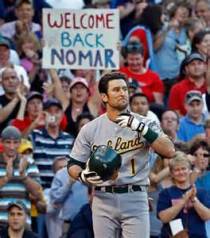 Hicks had made little effort to keep negotiations quiet. Hicks was furious with Sox CEO Larry Lucchino, to the point that Tom Werner became the Sox point man with the Texas owner. Lucchino and union lawyer Gene Orza took whacks at each other. Garciaparra never recovered from the shock of learning that the Sox had sought A-Rod, even as Henry later explained he initially thought that they could have co-existed. And A-Rod resigned himself to remaining with the Rangers.
Hicks had made little effort to keep negotiations quiet. Hicks was furious with Sox CEO Larry Lucchino, to the point that Tom Werner became the Sox point man with the Texas owner. Lucchino and union lawyer Gene Orza took whacks at each other. Garciaparra never recovered from the shock of learning that the Sox had sought A-Rod, even as Henry later explained he initially thought that they could have co-existed. And A-Rod resigned himself to remaining with the Rangers.
The upshot, of course, is that the Sox won two World Series in the next four seasons without A-Rod, and won their third in the 10 seasons in which Rodriguez has been a Yankee. And A-Rod alienated his longtime friend Derek Jeter, the first of many soap operas that would mark his time in New York. And then came the PED revelations.
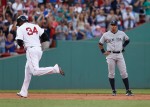 That part of the story, sadly, would have been no different had he played for the Red Sox instead of the Yankees. But the rest of it? Ten years later, I still believe it could have gone a different way for A-Rod in Boston. Instead of a wary Jeter, he would have been embraced by David Ortiz, who remains one of his good friends in the game. He also was very close with Ordonez, who would have combined with A-Rod to more than compensate for the loss of right-handed power Ramirez represented.
That part of the story, sadly, would have been no different had he played for the Red Sox instead of the Yankees. But the rest of it? Ten years later, I still believe it could have gone a different way for A-Rod in Boston. Instead of a wary Jeter, he would have been embraced by David Ortiz, who remains one of his good friends in the game. He also was very close with Ordonez, who would have combined with A-Rod to more than compensate for the loss of right-handed power Ramirez represented.
He would have remained at short, where his value to the club would have been greater than it was to the Yankees at third.
In his first five seasons with the Yankees, through the 2008 season, Rodriguez hit 208 home runs. No one in baseball hit more. And Fenway is much kinder to right-handed hitters than Yankee Stadium. He was one of 10 players who had an on-base percentage greater than .400 in that time. He averaged 6.8 in WAR in that time.
Call me naïve, but I think Boston would have brought out the best in him, and he would have been loved for it.
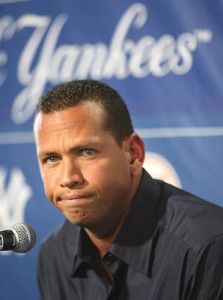 We’ll never know, of course. And in this town, I am well aware, that’s hardly a popular thought. But there’s a part of me that has never forgotten the shining promise of that 18-year-old and laments that it has ended the way it has.
We’ll never know, of course. And in this town, I am well aware, that’s hardly a popular thought. But there’s a part of me that has never forgotten the shining promise of that 18-year-old and laments that it has ended the way it has.
_____
On a personal note: I was at that same game, just a few rows up and sitting between home and the visitors dugout (best seats I ever scored) for that Fenway game where an 18-year-old Alex Rodriguez debuted for Seattle. I sat close enough to see all the awe and wonder on the face of a kid who was walking out into a Cathedral to take his first big league swings. My how times changed as he was on his way to Texas!
Before the PED’s, before the even more inflated ego and sense of entitlement, I was not a fan of the proposed trade. I was a Nomar guy. I didn’t dislike A-Rod at that point, I just disliked the perceived greed and the monster contract and the handcuffs that came with it. How could you as a team hit the free agent market for pitching and additions under those circumstances? Yeesh! Sure the Yankees did it and eventually put a World Series ring on A-Rod’s finger, but we won two in the same amount of time and of course just added the third.
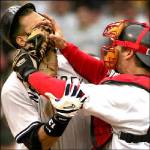 Would or could any of that have happened if we found A-Rod under the tree for Christmas of 2003? Maybe a ring… two at an outside chance? Luckily, this is one of those Scarlett Hose / Bronx Bombers hypotheticals we don’t have to put too much emphasis on… after all, we came out for the better.
Would or could any of that have happened if we found A-Rod under the tree for Christmas of 2003? Maybe a ring… two at an outside chance? Luckily, this is one of those Scarlett Hose / Bronx Bombers hypotheticals we don’t have to put too much emphasis on… after all, we came out for the better.
Kevin Youkilis wasn’t kidding when he said he wanted to play closer to the Pacific Ocean….
Kevin Youkilis, who just recently rebuffed the Bronx Bombers in talks of playing another season in New York due to ‘wanting to play closer to his home on the West Coast’, has agreed to a one-year contract with the Tohoku Rakuten Golden Eagles in Japan for the 2014 season, his agent confirmed Friday.
Youkilis will have a $4 million base salary and can earn $1 million in bonuses — including some based on walks, a provision not allowed in major league contracts.
“He’s looking at this as a terrific life experience for his family,” agent Joe Bick said. “There were a number of opportunities and inquiries and conversations that took place here [in the U.S.]. But in the final analysis, this is what the family decided they wanted to do.”
 Youkilis, 34, is a three-time All-Star and a .281 career hitter in 10 seasons with the Boston Red Sox, Chicago White Sox and New York Yankees. His best season came in 2008, when he hit .312 with 29 homers and 115 RBIs with the Red Sox and won the Hank Aaron Award.
Youkilis, 34, is a three-time All-Star and a .281 career hitter in 10 seasons with the Boston Red Sox, Chicago White Sox and New York Yankees. His best season came in 2008, when he hit .312 with 29 homers and 115 RBIs with the Red Sox and won the Hank Aaron Award.
Youkilis underwent back surgery last June and appeared in only 28 games with the Yankees. He’s expecting to play first and third for Rakuten, the defending Japan Series champion.
Bick said Youkilis, his wife, Julie, and their two children, ages 7 and 1, plan to spend the 2014 season together in Japan.
“Kevin’s intent is to play one more year,” said Bick, although he wouldn’t rule out Youkilis playing beyond the 2014 season.
At Rakuten, Youkilis may become teammates with star pitcher Masahiro Tanaka, who went 24-0 last season, While Tanaka wants to join the major leagues, Rakuten is reluctant to make him available in the new posting season, and the 25-year-old right-hander can’t leave as a free agent until after the 2015 season.
“We were talking with eight or nine other clubs over here,” Bick said. “In the final analysis, he said the right thing for my family and me is to go do this. It will be a wonderful life experience.”
MLB’s Hot Stove spending could eclipse $2 billion
No sport incites salary rage like Major League Baseball, so for those who bellyache the money is too big, consider this a fair warning to gulp a handful of Tums before reading the next sentence.
Teams are barreling toward $2 billion spent on free agents this offseason.
Now, they may fall short of that nice, round number and still absolutely obliterate the previous spending record: around $1.75 billion in the 2006 offseason, a number that includes major league free agents as well as the posting fees for Daisuke Matsuzaka and Kei Igawa.
Already teams have lavished approximately $1.543 billion on players, the latest a $130 million investment by the Texas Rangers for seven years of outfielder Shin-Soo Choo. He is the third nine-figure player of the offseason, joining Jacoby Ellsbury ($153 million) as an offset diamond around the center stone, Robinson Cano ($240 million).
 There is plenty more to come. If Japanese pitcher Masahiro Tanaka gets posted – his status remains in limbo – the $2 billion threshold is certain to be obliterated. Between his contract and the $20 million posting fee, teams expect to pay somewhere in the neighborhood of $120 million for Tanaka. Beyond him are three pitchers who reason says will cash in for around $60 million each (Ervin Santana, Ubaldo Jimenez and Matt Garza), an outfielder worth the same (Nelson Cruz), a shortstop a notch down from that (Stephen Drew), another starter sure to get multiple years (Bronson Arroyo), a bevy of relievers who will get papered (Fernando Rodney, Grant Balfour and Jesse Crain, among others) and the dregs of the class, who can fetch $5 million here, $3 million there and add up quickly.
There is plenty more to come. If Japanese pitcher Masahiro Tanaka gets posted – his status remains in limbo – the $2 billion threshold is certain to be obliterated. Between his contract and the $20 million posting fee, teams expect to pay somewhere in the neighborhood of $120 million for Tanaka. Beyond him are three pitchers who reason says will cash in for around $60 million each (Ervin Santana, Ubaldo Jimenez and Matt Garza), an outfielder worth the same (Nelson Cruz), a shortstop a notch down from that (Stephen Drew), another starter sure to get multiple years (Bronson Arroyo), a bevy of relievers who will get papered (Fernando Rodney, Grant Balfour and Jesse Crain, among others) and the dregs of the class, who can fetch $5 million here, $3 million there and add up quickly.
For those surprised, don’t be. Baseball’s economic system, as presently constituted, guaranteed free-agent salaries ballooning to unfathomable levels. A number of factors conspired to turn it into even more of a money booth than in the past.
First are the revenues. Back in 2006, a year before the recession started, baseball’s revenues were around $5.5 billion. Today, they are nearly $8.5 billion. And only now is free-agent spending catching up; over the previous three offseasons, it fell somewhere in the $1.3 billion to $1.4 billion range.
More than that are the mechanisms in place that more or less force teams to spend their money on free agents. Simply put: They can’t spend it anywhere else. The league capped how much teams can spend on the draft and international free agents. Many of the best players in the game don’t even make $1 million a season because the system artificially depresses salaries for the first three years of a career. Plenty of the best would-be free agents forgo the open market by signing long-term extensions, which can be for big money, sure, but almost every time represent a discount against what the player would receive with his services available to all 30 teams.
For those, then, with the patience to wait for free agency and the luck to do so coming off even a decent walk year, the rewards are massive – enough so to make you wonder if there will be some sort of a market correction in which pre-free-agency extensions start to inch closer to the open market or players who might’ve been locked up opt instead to chance free agency.
 There is an expectation within the industry that at least a couple of the monster class of free-agent pitchers next offseason will sign extensions. The group includes Clayton Kershaw (who will command the first deal for a pitcher over $200 million), Max Scherzer, Jon Lester, James Shields, Homer Bailey and Justin Masterson. If each went to free agency, there’s a good three-quarters of a billion dollars among the six, more than making up for a hitting class that includes Hanley Ramirez and a group that is best referred to as Et Cetera.
There is an expectation within the industry that at least a couple of the monster class of free-agent pitchers next offseason will sign extensions. The group includes Clayton Kershaw (who will command the first deal for a pitcher over $200 million), Max Scherzer, Jon Lester, James Shields, Homer Bailey and Justin Masterson. If each went to free agency, there’s a good three-quarters of a billion dollars among the six, more than making up for a hitting class that includes Hanley Ramirez and a group that is best referred to as Et Cetera.
It’s one of the biggest reasons the Rangers went so hard after Choo, giving him more years and money than they wanted: the outfield market next year is paltry, and they’ve got goo-gobs of TV money from local and national sources to cover it. Give the Rangers this much: They’ve long made a habit of being ahead of other teams in how they spend their money. They went bigger in Latin America than any other team before the spending cap, then blew by it when the penalties weren’t as severe as they are now. This offseason, they’ve committed more than a quarter billion dollars to Choo and Prince Fielder and helped spearhead the spending that left the American League West as baseball’s most munificent division and the AL spending nearly three times as much as its National League counterparts.
The five AL West teams have combined to heap $466.6 million on free agents – Cano and Choo account for 79.2 percent of that – while the AL East is at $399.25 million (with the Yankees at 79.1 percent of that). Next is the AL Central ($268.75 million), followed by the three NL divisions: East ($182.98 million), West ($148.25 million, not including the Hunter Pence or Tim Lincecum deals because they signed before free agency) and Central ($77.95 million – and, without Jhonny Peralta, less than $25 million combined).
Thirteen players by themselves have signed for $25 million, and another seven have exceeded the $20 million mark. It’s almost exactly like 2006, with 15 at $25 million-plus and 20 at $20 million-plus. With the five starters, Cruz and Drew left to go, this year’s numbers should dwarf ’06 in all respects.
Welcome to baseball in 2014, which rewards free agency more than ever. Ask Robinson Cano. Ask Jacoby Ellsbury. Ask Shin-Soo Choo. Ask any of the middle relievers cashing in for $6 million a year, the back-end starters and utilitymen getting four-year guarantees, the fourth outfielders getting paid what used to be All-Star wages. The union sought free agency with such fervor 40 years ago because the brilliant men leading it saw this day, when owners would make money hand over fist and give players their fair share.
Even those brilliant men could not fathom just how big that number would be: $2 billion or bust.
Recent MLB Contracts That Became Nightmares…
With free agents cashing in big this off-season, it’s wise for teams to revisit some of the horrible contracts of the past. From extensions for franchise players to ill-advised free agent deals, there have been countless misfires by Major League Baseball general managers and owners in recent years. Here are seven contracts that quickly turned into nightmares for the teams in question.
Ryan Howard, Philadelphia Phillies
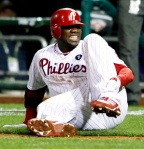 Though critics were horrified by the deal, Ryan Howard was all smiles when the Phillies offered him a five-year contract extension worth $125 million. Instead of waiting until the end of his contract, which expired after 2011, the Phillies locked up their aging slugger early in 2010.
Though critics were horrified by the deal, Ryan Howard was all smiles when the Phillies offered him a five-year contract extension worth $125 million. Instead of waiting until the end of his contract, which expired after 2011, the Phillies locked up their aging slugger early in 2010.
This move became a case of how not to manage a franchise’s money. Age and injury caught up with Howard quickly, making the deal a major black eye for Phillies GM Ruben Amaro. Philadelphia still owes Howard $25 million per year through 2016 for what is likely going to be average production.
A.J. Burnett, New York Yankees
 As a member of the Toronto Blue Jays, A.J. Burnett made mincemeat of mighty Yankees lineups. When it came time for Burnett to hit free agency, it coincided with the Yankees opening their new stadium after missing the playoffs for the first time in 14 years. The Yankees pounced, inking the right hander to a five-year, $82.5 million deal.
As a member of the Toronto Blue Jays, A.J. Burnett made mincemeat of mighty Yankees lineups. When it came time for Burnett to hit free agency, it coincided with the Yankees opening their new stadium after missing the playoffs for the first time in 14 years. The Yankees pounced, inking the right hander to a five-year, $82.5 million deal.
Aside from a successful 2009 campaign — which culminated in the Yankees’ 27th World Series title — New York and Burnett were a disaster together. The Yankees eventually pawned off the right hander to Pittsburgh for a few no-name prospects, eating much of the remaining cash owed to Burnett in the process.
Barry Zito, San Francisco Giants
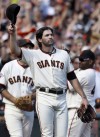 The signing of Barry Zito may have sounded good in theory, but few baseball minds thought the southpaw was worth $126 million over the course of seven years. The Giants were dismayed early and often by Zito’s performance, though the lefty did contribute to one World Series win for San Francisco. Now that his contract has ended, we’re able to see what he delivered to the Giants for $126 million: In 208 appearances, Zito went 63-80 with an ugly 4.62 earned-run average.
The signing of Barry Zito may have sounded good in theory, but few baseball minds thought the southpaw was worth $126 million over the course of seven years. The Giants were dismayed early and often by Zito’s performance, though the lefty did contribute to one World Series win for San Francisco. Now that his contract has ended, we’re able to see what he delivered to the Giants for $126 million: In 208 appearances, Zito went 63-80 with an ugly 4.62 earned-run average.
Albert Pujols, Los Angeles Angels
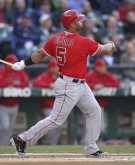 Too early to call? It’s possible, but it looks as if the Los Angeles Angels have an albatross on their hands with the 10-year, $240 million contract they handed to Albert Pujols after the 2011 season. Pujols has had the two worst seasons of his career thus far for the Angels, with his 2013 campaign enough to depress even the most optimistic of fans. At $24 million per year, 17 home runs simply won’t do the trick. This may turn out to be the worst contract of all time when it terminates after the 2021 season.
Too early to call? It’s possible, but it looks as if the Los Angeles Angels have an albatross on their hands with the 10-year, $240 million contract they handed to Albert Pujols after the 2011 season. Pujols has had the two worst seasons of his career thus far for the Angels, with his 2013 campaign enough to depress even the most optimistic of fans. At $24 million per year, 17 home runs simply won’t do the trick. This may turn out to be the worst contract of all time when it terminates after the 2021 season.
Carl Pavano, New York Yankees
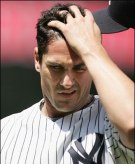 Four years for $40 million doesn’t sound like an awful contract. However, the Yankees got next to nothing from the underachieving, tabloid-starring whipping boy that was Carl Pavano in pinstripes. Pavano was victimized by one curious injury after another while under contract for New York, with a buttocks injury keeping him out of the rotation at one point.
Four years for $40 million doesn’t sound like an awful contract. However, the Yankees got next to nothing from the underachieving, tabloid-starring whipping boy that was Carl Pavano in pinstripes. Pavano was victimized by one curious injury after another while under contract for New York, with a buttocks injury keeping him out of the rotation at one point.
In terms of sheer uselessness, it’s difficult to top the Pavano contract. The right hander pitched just 145 innings in 26 appearances over four seasons for the Yankees. That amounts to $273,972 per inning.
Josh Hamilton, Los Angeles Angels
 Hitting Albert Pujols and Josh Hamilton behind Mike Trout sounds like the makings of a new murderers’ row, but it hasn’t panned out that way for the Angels. After signing a contract worth $125 million over five years, Hamilton hit a career-worst .250 with just 21 home runs in 2013. At $25 million per year, those numbers simply don’t cut it. The Angels will need both Hamilton and Pujols to return to form for the franchise to right itself.
Hitting Albert Pujols and Josh Hamilton behind Mike Trout sounds like the makings of a new murderers’ row, but it hasn’t panned out that way for the Angels. After signing a contract worth $125 million over five years, Hamilton hit a career-worst .250 with just 21 home runs in 2013. At $25 million per year, those numbers simply don’t cut it. The Angels will need both Hamilton and Pujols to return to form for the franchise to right itself.
Alex Rodriguez, New York Yankees
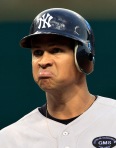 At 10 years and $275 million, there was really no way the Yankees could have gotten their money’s worth from the ill-advised contract they dished out to Alex Rodriguez at age 32. A-Rod went from MVP to PR nightmare for the Yankees, who have watched the once-epic player become an embarrassment to the organization, sport, and himself.
At 10 years and $275 million, there was really no way the Yankees could have gotten their money’s worth from the ill-advised contract they dished out to Alex Rodriguez at age 32. A-Rod went from MVP to PR nightmare for the Yankees, who have watched the once-epic player become an embarrassment to the organization, sport, and himself.
Both sides would benefit from a swift resolution to the pending lawsuits, suspensions, and other legal affairs hanging over Rodriguez. Once upon a time, he seemed destined to be one of Major League Baseball’s all-time greats.
I’m sure if went a little further back in the time machine, we’d find a good number of Tom Yawkey and later Lou Gorman inspired nightmares for the Sox of the 1970’s through the early 1990’s. Jack Clark ring a bell? Let’s not even get into Carl Crawford.
You’re Welcome…..
On the day he will be introduced as the newest New York Yankee, outfielder Jacoby Ellsbury took out a full-page ad in the Boston Globe to thank Red Sox fans for seven years of “great memories.”
Ellsbury, fresh off winning his second World Series ring with the Red Sox, agreed to a $153 million deal with New York last week. The contract includes a $21 million team option for the 2021 season, with a $5 million buyout. If the option is exercised, the deal would be worth $169 million over eight years.
Jacoby will wear No. 22 with the Yankees, (he wore No. 2 with the Red Sox, but obviously that belongs to Yankees captain Derek Jeter) taking over the number of Roger Clemens, another Boston Red Sox star who moved south to New York.
Ellsbury, who turned 30 in September, led the majors with 52 stolen bases despite being hobbled late in the season by a broken right foot. The lefty-hitting leadoff man batted .298 with nine homers and 53 RBIs, and the short right-field porch at Yankee Stadium should boost his power numbers.
He is part of a rebuilding plan by the Yankees, who lost All-Star second baseman to Seattle. New York also agreed to deals with catcher Brian McCann and outfielder Carlos Beltran.
MLB, NPB agree to new free agent posting system
MLB and Nippon Professional Baseball have agreed in principle to a new posting system, reports Joel Sherman of the New York Post. As Sherman notes, the final step prior to approval is for MLB’s executive council to sign off on the deal, which is expected to happen soon.
As for the details, it’s likely as expected: The NPB team posting a free agent will reportedly be able to name a posting fee up to $20 million. At that point, all interested teams will agree to the posting fee, and the free agent in question will then be allowed to negotiate with the teams that have consented to the specific fee. However, only the team that signs the free agent will owe the posting fee to the player’s former NBP club.
This new system is a win for MLB, as the old format permitted posting fees much higher than $20 million — Yu Darvish’s $51.7-million tab and Daisuke Matsuzaka’s $52.1-million fee, for notable instance (ugh..!).
All of this means we’ll probably soon have some clarity regarding the status of coveted Japanese right-hander Masahiro Tanaka, who’s generally regarded as the top potential free agent pitcher on the market. Tanaka’s current team, the Rakuten Golden Eagles, have in the recent past hinted that they may consider not posting their star under the new rules, but that stance seems to have softened this week. The general feeling is that if Tanaka wishes to make the jump, then he’ll be allowed to do so.
On that front, it’s worth noting that Rukuten’s team president, according to Yahoo!’s Jeff Passan, is set to arrive at the Winter Meetings on Tuesday. The Yankees, Cubs, Mariners and Dodgers are among the teams believed to have strong interest in the 26-year-old Tanaka.
One would have to believe that under the new system, the idea of parity between MLB’s ‘Haves’ and ‘Have Nots’ will be at least, a little, improved. Teams who otherwise would have sat back and watched due to the idea of paying over $50 million (in some cases a third of annual payroll for the ‘Have Nots’) for the right just to talk to the player may now be more inclined to take a chance and upset their division norm, whatever that norm may be.
If the Astros (it’s just an example, calm yourself) can take a leap and snag an import centerpiece to build upon, they can stand alongside the likes of The Dodgers, Bombers and Scarlett Hose… at least until they’re forced to trade that centerpiece for a bag of fungo bats, cash and some prospects.
Kevin Youkilis wants to play near West Coast
Updating the status of free agent Kevin Youkilis and the Yankees, here’s this tweet from Jack Curry of YES Network: “Cashman called Youkilis’s agent to gauge interest in returning to Yankees. Youkilis appreciated call, but wants to play near home in Cali.”
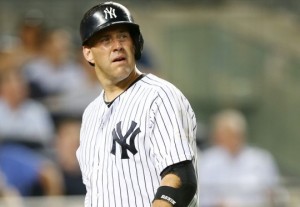 The Yankees’ interest is understandable, since they could use some additional depth at the infield corners. After all, Alex Rodriguez may be facing a lengthy suspension, and Mark Teixeira is coming off wrist surgery.
The Yankees’ interest is understandable, since they could use some additional depth at the infield corners. After all, Alex Rodriguez may be facing a lengthy suspension, and Mark Teixeira is coming off wrist surgery.
Youkilis, though, appears to be inclined to sign with a team near the West Coast. Although, as always in these matters, money sometimes has the final word.
Youkilis, 34, is coming off an injury-riddled 2013 season in which he batted .219/.305/.343 in just 28 games for the Yanks. For his career, he owns a nifty OPS+ of 123, but he hasn’t produced at a high level since 2011.
Curse..? Bambino..? What is it you speak of?
Jacoby Ellsbury is just the latest in a long line of Red Sox who have defected (or been shipped to… let’s be fair) to the Bronx.
Yes, Babe Ruth is most famous and spawned the 86 year ‘curse’ that generations of New Englanders swore would (and in many cases did) outlive them. But to be quite serious and objective… The Babe was hardly alone.
Herb Pennock: Somewhat overshadowed by his corpulent teammate (see above), the Hall of Fame lefty went from serviceable starter with the Sawx to an ace for a Bombers ballclub that won its first World Series title in 1923 … and a few more after that.
Sad Sam Jones: Jones, dealt to Boston for Hall of Famer Tris Speaker, won 23 games for the Sox in 1921. So of course that December he was traded to the Yankees. Jones had a bumpy ride in the Bronx, but he did post 21 wins and a no-hitter for the 1923 champs.
Joe Dugan: Boston shipped Jumping Joe to New York midway through the 1922 season, and there he helped the Yanks win their second AL pennant. He’d play in five World Series in pinstripes overall. (The Bombers won three of them.)
Waite Hoyt: In case you thought the ’20s weren’t rough enough for Red Sox fans, this Hall of Fame hurler joined the Yanks in 1921 after two seasons in Boston, averaging 18 wins over the next eight seasons and winning a league-high 22 games for the famed ’27 Bombers.
Red Ruffing: Ruffing lost 20-plus games two years in a row for the Red Sox in 1928 and ’29 — then won 20 or more for the Yankees in four straight seasons, starting in 1936, en route to the Hall of Fame.
Sparky Lyle: Lyle won a Cy Young in 1977 and played on two Yankees title teams. The guys the Bombers traded for him? Danny Cater and Mario Guerrero, who hit a collective .252 in Boston and never played more than 93 games in any of their seasons with the Sox.
Luis Tiant: Unlike the previous players on our list, Tiant joined the Yankees in the twilight of his career, winning 21 games in two seasons in the Bronx (1979 and ’80) after spending several years as the ace of the Red Sox.
Wade Boggs: Boggs put up most of his numbers in Boston, but when it came time for the Hall of Fame third baseman to finally win a title, he did it in the Bronx — famously riding around Yankee Stadium on a horse in 1996.
Roger Clemens: Rocket won three Cy Young Awards in Boston, compared to just one with the Yankees. But two World Series titles (in 1999 and 2000) in the Bronx more than made up for it.
Tom Gordon: Flash became a folk hero in Boston as a starter turned All-Star closer in 1998. He even helped inspire a Stephen King novel, “The Girl Who Loved Tom Gordon.” Did that girl become a Yankees fan when he joined the Bombers’ bullpen six years later?
Doug Mientkiewicz: Eye Chart’s career doesn’t stack up against many of the players on our list, but when the Red Sox finally won a title in 2004, he was the toast of Beantown. The Yanks picked him up in 2007 after he’d had season-long stints with the Mets and Royals.
Johnny Damon: The Caveman tormented the Yanks while a Sox star on the ’04 champs — then crushed Boston fans when he went clean-shaven and signed with the Bombers in 2006. His baserunning heroics in the 2009 World Series won’t soon be forgotten, by either fan base.
Derek Lowe: Lowe was the winning pitcher in Game 7 of the 2004 ALCS, helping the Sox break the Bambino’s curse. After pitching for the Dodgers, Braves and Indians, Lowe signed with the Yankees midway through the 2012 season.
Kevin Youkilis: Youk became a Yank prior to the 2013 season, but a back injury limited The Greek God of Walks to just 28 games (and eight bases on balls, if you’re scoring at home).


